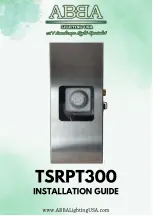
FSG 90F System
3. Installation
Page
24
November 2000
W. Dittel GmbH
3.5
Airborne wiring
Refer to Figures 3-5 to 3-7 of on-board wiring.
3.5.1
General recommendations
•
Always ensure continuously good, stable electrical contacts, and efficient RF
interference suppression of all electrical systems like generator/alternator, ignition
etc., especially consider vibration and corrosion effects. Consult the aircraft
installation licensing inspector.
•
Do not
allow the harness to droop between clamps, especially if it is a heavy
harness.
•
Do not
allow the wires in the harness to come in contact with sharp surfaces or ride
against any movable surface.
•
Do not
install without allowing for service loops, this will help to prevent undue stress
on the connectors and allow for easier repair of wire terminations.
•
Do not
allow harness to route through high heat areas without adequate thermo
protection.
•
Do not
install harnesses in areas that are subject to chemical damage.
•
Radio wiring shall be located most distant to other, high AC currents carrying leads.
Route all wiring including antenna cable distant from aircraft control and handling
components. Place DC power lines at least 15 cm away from compass.
•
Use only aviation grade wiring material (LN 9251 resp. LN 9253) in self-extinguishing
quality, and with > 500 Volt isolation.
•
Prescribed cable diameters must be complied with.
•
Ground loops must be avoided.
•
Cables are soldered to the DA-25S connector. Solder joints shall be supported by
shrinking or rubber sleeves. Cable connector case mounting shall not clamp or
damage the wiring.
•
The
FSG 90F(X)
is protected against reversed polarity only when using a suitable DC
supply protection fuse. For 6 Watt models, we suggest a 3.15 Amp. quick acting fuse
or an automatic 3 amp circuit breaker. For 10 Watt models (suffix “-H1), we suggest
a 5 amp quick acting fuse, or an automatic 5 amp circuit breaker. Without proper fuse
protection, the radio unit may become severely damaged, warranty validity
terminates.
•
Power bus circuit breakers are to be mounted in the A/C breaker panel or instrument
panel such that they will be accessible in flight and safe from physical damage.
•
Before first connection to the
FSG 90F(X)
radio is made, carefully cross-check all
wiring details, especially DC supply polarity.
•
Secure the plugged SUB-D connector by the sliding lock retainer to avoid unwanted
loosening.
•
For easy installation, prefabricated wiring harnesses for all kind of aircraft are
available from
Walter Dittel GmbH
.
•
Electronic variometer seldom comply with airborne type approval requirements. All of
the known models at printing time of this manual have - to our knowledge - a too high
radiated RF interference emission. In transmit mode, the operator may even be faced
with radio energy based functional variometer influence. Slight improvement may be
achieved when the variometer wiring is both shielded and routed not in parallel but
distant to the radio wiring. Perhaps, short but bulky grounding contacts between all
radio and variometer cases may improve this E-variometer RF susceptibility.
Further measures to improve RF immunity may be obtained from variometer
manufacturer.







































